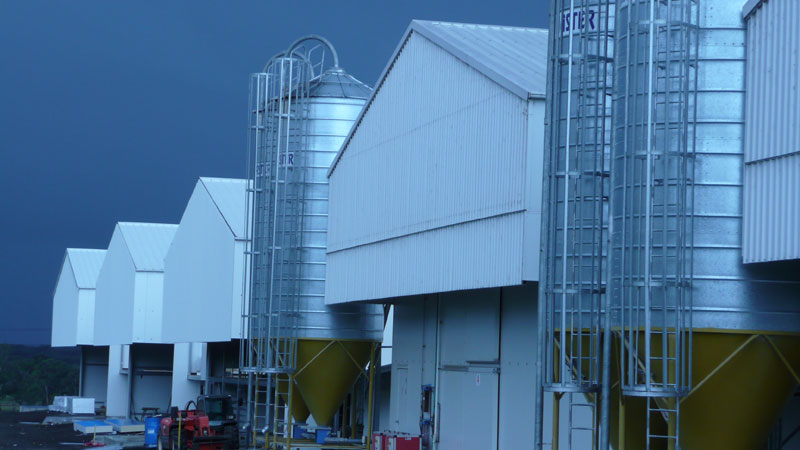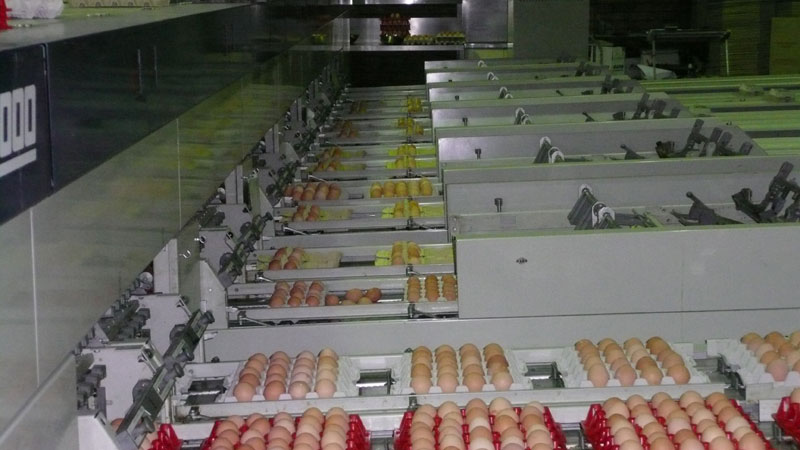Layer farm sequence
Layer farm sequence
A standard procedure is followed for the Layer farm sequence. This procedure starts when female chicks are raised into pullets for commercial egg production. This stage is called ‘rearing’, and there are several common rearing systems. Some farms raise layer chicks on a litter floor in a shed similar to a meat chicken shed. Other pullets are either finished off or reared entirely in wire-floored cages.

Layer farms are capital intensive
Brooding (Day-old to 6 weeks)
When a hen sits still for a prolonged period without eating or drinking normally, she is said to be ‘broody’. This is a normal process during which the hen stops producing eggs in order to incubate a nest full of eggs. When the eggs hatch the hen then cares for the chicks by keeping them warm and finding feed and water for them. Modern strains of chicken have been selected not to go broody so that more eggs are laid over a period of time.
When rearing chicks commercially the aim is to do the same thing as the hen. The stage of life when chicks need some additional heat is called the brooding stage. It lasts for up to six weeks, depending on the temperature of the environment until the chicks can control their body temperature themselves. From day-old, they usually receive chick starter feed which aims to ensure they have plenty of protein and energy for body growth.
Growing (6 to 20 weeks)
Once chicks are able to control their body temperature they still need to be protected from climate extremes. At this stage, they receive pullet grower feed which is less expensive and contains only 15% to 17% protein and 7% less energy than the starter feed.
Beak trimming and some vaccinations are done during the grower stage to prepare the birds for their adult life as laying hens. Anything that limits growth at this time can affect their ability to lay well. However, excessive feeding at this time can be harmful, again leading to poor production.
Restriction to feed supply to birds during growing stops them from growing at a fast rate and results in both feed savings and increased egg production when the birds mature. Careful weekly weighing of the birds is essential to restrict body weight and work out how even the flock is growing. Breeding companies recommend what weight birds should be at each age.
Moving
Pullets are usually moved into their laying quarters, at 16-18 weeks of age, before they reach sexual maturity. This ensures that they are settled in before egg production begins. Handling birds at any time must be done with care to avoid injury. As pullets mature into laying hens they are fed a layer ration designed to enable them to perform best.
Adult layer (20 to/up to 78 weeks)
Adult hens are the real workers of the industry. For best performance, they need to be fed carefully and kept in a house at 21-28oC. This means that hen houses are designed to keep as near as possible to this temperature year-round. The hens are checked regularly to monitor their health and medicines may be administered as needed. Tinted egg strains usually require less feed (105g feed/hen/day) than brown egg strains (120g feed/hen/day).
The quality of feed provided to hens may be varied for the level of production. Hens can need more nutrients just before and during their peak production than at other times. This is called phase feeding. It can be economical to adjust rations for such high demand periods.

Egg grading for size
Egg collecting and grading
Mechanical collection of eggs is common in modern layer farms. It takes about 26 hours for each egg to develop and each hen lays an egg a little later each day. This is not an exact thing and most eggs are laid in the morning. Eggs should be collected regularly and transferred from the hen house to an egg room where they are graded or checked for weight and for damaged shells. A sample of eggs is often broken open to check internal quality. Eggs are packed into cartons for 12 eggs or trays of 30 eggs for sale. Prices vary with egg size, so eggs must be separated on the basis of egg weight. This is done automatically by a machine called an egg grader.
Marketing
Eggs are stored in a cool room at about 13oC and transported in an insulated truck. Unfortunately, many shops selling eggs do not store them under ideal conditions. In the home and shop situation, it is best to store them at normal refrigerator temperature (4-6oC). Marketing involves a range of prices, depending on the different sizes of eggs, different brands, or other differences which attract particular buyers. Free-range, organic and fat modified eggs are among the varieties available.
External links
- Australian Eggs presents a comprehensive overview of the Australian egg industry.

